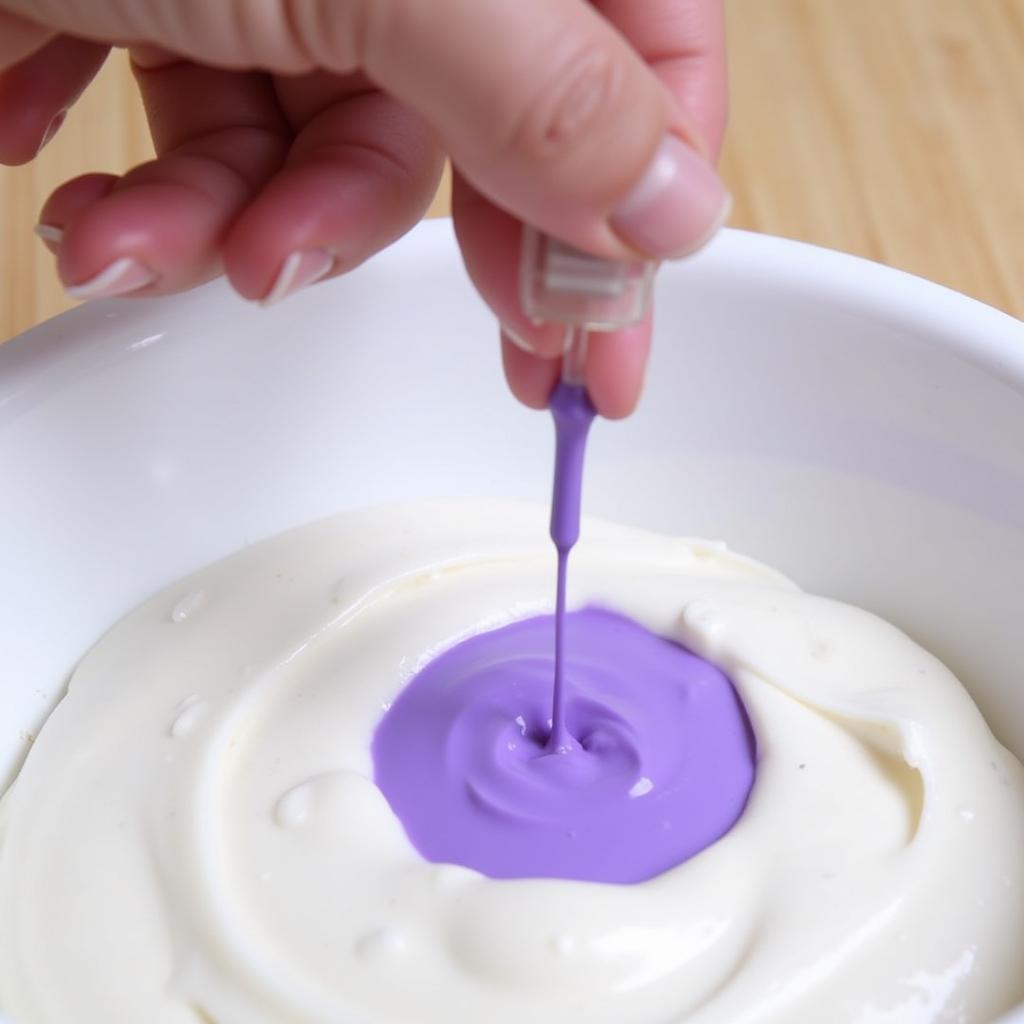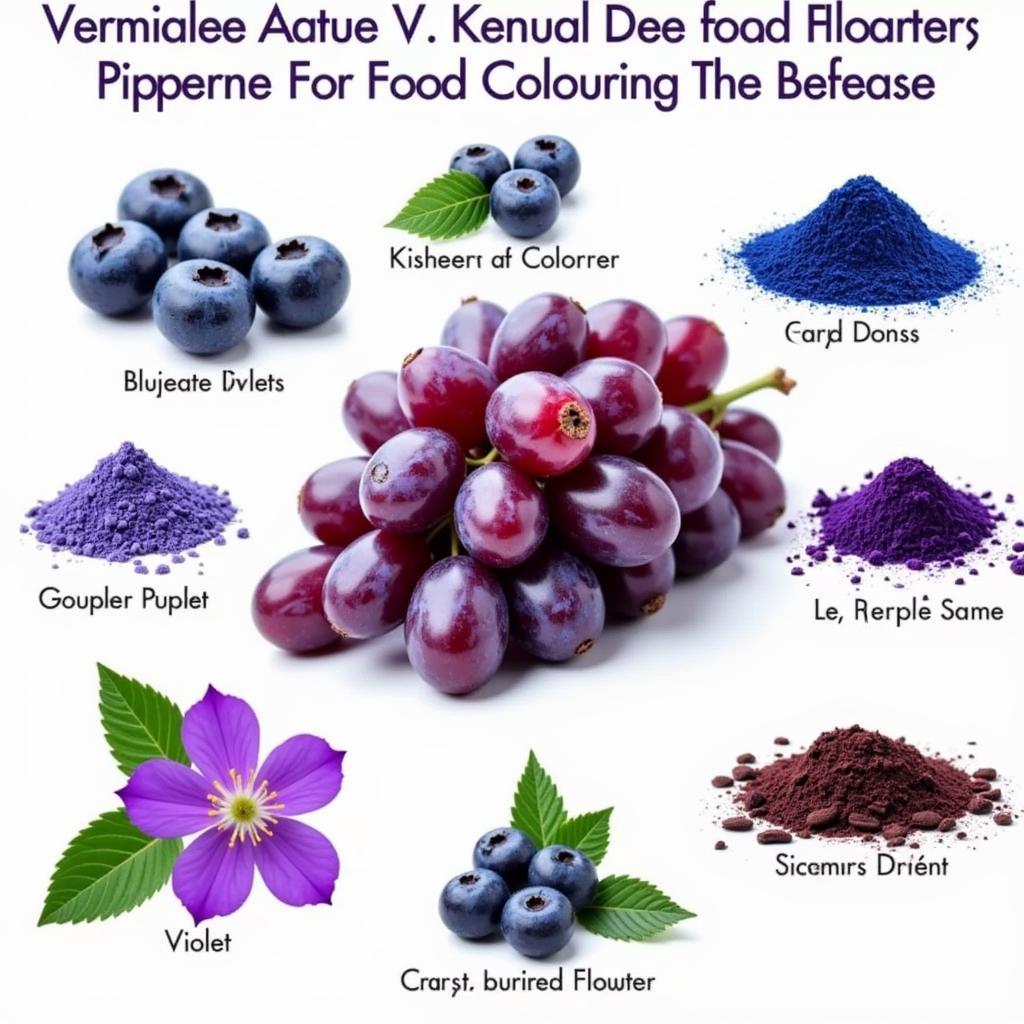Violet Food Colouring, a vibrant and versatile hue, adds a touch of magic to culinary creations. Whether you’re baking a whimsical cake, crafting intricate desserts, or simply adding a pop of colour to your everyday meals, understanding the nuances of violet food colouring can elevate your cooking to a new level. From its various forms and applications to achieving the perfect shade and exploring its fascinating history, this guide delves into everything you need to know about violet food colouring.
Unveiling the Spectrum: Types of Violet Food Colouring
Violet food colouring comes in various forms, each with its own characteristics and applications. Liquid food colouring is a common choice, offering ease of use and a wide range of shades. Gel food colouring, on the other hand, provides a more concentrated colour payoff, ideal for achieving deep, vibrant violets. Powdered food colouring, favoured for its stability and long shelf life, offers precise control over colour intensity. Choosing the right type depends on your specific needs and desired outcome. Need a deep violet? purple food colouring gel is your answer.
What are the different types of violet food colouring available? Liquid, gel, and powder forms cater to various needs and colour intensities.
Achieving the Perfect Shade: Tips and Tricks
Achieving the perfect shade of violet can be an art form. Start with a small amount of colouring and gradually add more until you reach the desired intensity. Remember, different brands and types of food colouring can vary in concentration, so always test on a small portion before applying it to your entire creation. White or light-coloured bases work best for showcasing vibrant violets, while darker bases may require more colouring to achieve the same effect. For a lighter shade, consider lavender food color. If you’re aiming for a true purple, learn how to make purple with food dye.
How do I achieve the perfect shade of violet? Start small, test on a sample, and gradually add more colour until you reach your desired intensity.
 Mixing violet food colouring to achieve different shades.
Mixing violet food colouring to achieve different shades.
Beyond Baking: Culinary Applications of Violet Food Colouring
While often associated with baking, violet food colouring has a wider range of culinary applications. From vibrant cocktails and mocktails to colourful pasta dough and even eye-catching sauces, the possibilities are endless. Imagine a lavender-infused lemonade with a hint of violet colouring, or a batch of homemade pasta transformed into a whimsical purple delight.
What are some creative uses for violet food colouring beyond baking? It can be used to add vibrant hues to cocktails, pasta dough, sauces, and more!
A Colourful History: The Origins of Violet Food Colouring
The history of violet food colouring is as rich and vibrant as the colour itself. From natural sources like berries and flowers to the development of synthetic dyes, the quest for violet hues has spanned centuries. Early civilizations used natural pigments to colour their food, while the advent of modern chemistry brought about a wider range of stable and accessible dyes.
Where did violet food colouring originate? Natural sources like berries and flowers were used in ancient times, paving the way for the synthetic dyes we use today.
 Natural ingredients used to create violet food colouring.
Natural ingredients used to create violet food colouring.
From Purple to Lavender: Exploring Related Hues
Violet is a close relative of purple, and often the terms are used interchangeably. While violet leans towards a bluer undertone, purple encompasses a broader range of shades, including those with reddish undertones. Lavender, a delicate and paler version of violet, offers a softer and more subtle aesthetic. Understanding these nuances can help you choose the perfect shade for your culinary creations. If you are interested in a different shade of purple, you can check out our guide on purple food colour. For a subtler shade, blue food gel could be a great option.
What’s the difference between violet, purple, and lavender? While often used interchangeably, violet has a bluer undertone, purple encompasses a wider range, and lavender is a paler, softer shade.
Conclusion: Embrace the Vibrancy of Violet Food Colouring
Violet food colouring, with its versatility and visual appeal, opens up a world of creative possibilities in the kitchen. Whether you’re a seasoned baker or a culinary enthusiast, understanding the nuances of this vibrant hue can elevate your dishes to a new level of artistry. From achieving the perfect shade to exploring its diverse applications, embrace the magic of violet food colouring and transform your culinary creations into masterpieces. Remember to experiment, have fun, and let your creativity shine through!
FAQ: Violet Food Colouring
- Is violet food colouring safe to consume? Yes, most commercially available violet food colourings are FDA-approved and safe for consumption.
- Can I mix violet food colouring with other colours? Absolutely! Experimenting with colour combinations can lead to exciting new shades.
- How do I store violet food colouring? Store in a cool, dark place away from direct sunlight to maintain its vibrancy.
- Does violet food colouring affect the taste of food? In most cases, the amount of food colouring used is so small that it doesn’t noticeably alter the taste.
- Can I use natural alternatives to violet food colouring? Yes, natural ingredients like beetroot juice and blueberry extract can provide violet hues.
- How do I remove violet food colouring stains? Soaking stained items in cold water and then washing them with detergent can often remove the stains.
- Where can I buy violet food colouring? Most supermarkets, baking supply stores, and online retailers carry violet food colouring.
For further assistance, contact us at Phone Number: 02437655121, Email: minacones@gmail.com, or visit us at 3PGH+8R9, ĐT70A, thôn Trung, Bắc Từ Liêm, Hà Nội, Việt Nam. We have a 24/7 customer support team.